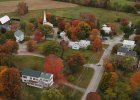macfawlty
Well-Known Member
I believe the primary factor at play is shutter speed - the camera is not on a tripod, it’s floating in the air subject to wind and if you were up there with it, you’d see it bouncing around. The farther away a subject is in the scene, the softer it will be. The gimbal does a remarkable job at stabilizing considering. A good target for shutter speed would be 1/500 or higher. At 1/250 or lower, consider an ISO of 200 or perhaps 400. It’s a trade off as you can do NR and sharpening in post, but there’s no fix for a blurry image. Of course, the ISO 400 is gonna be softer either way. I always use AEB of 3 or 5 images depending on exposure variance in the scene. If the scene is worth the effort, I’d shoot it a few times as I’ve noticed that some images can be more blurry than others due to the drone bouncing in the wind.
The other thing I’d recommend is to move closer the the scene and shoot a panorama. [edited the previous response as it was an overly complicated and flawed workflow!]
The other thing I’d recommend is to move closer the the scene and shoot a panorama. [edited the previous response as it was an overly complicated and flawed workflow!]
Last edited:













